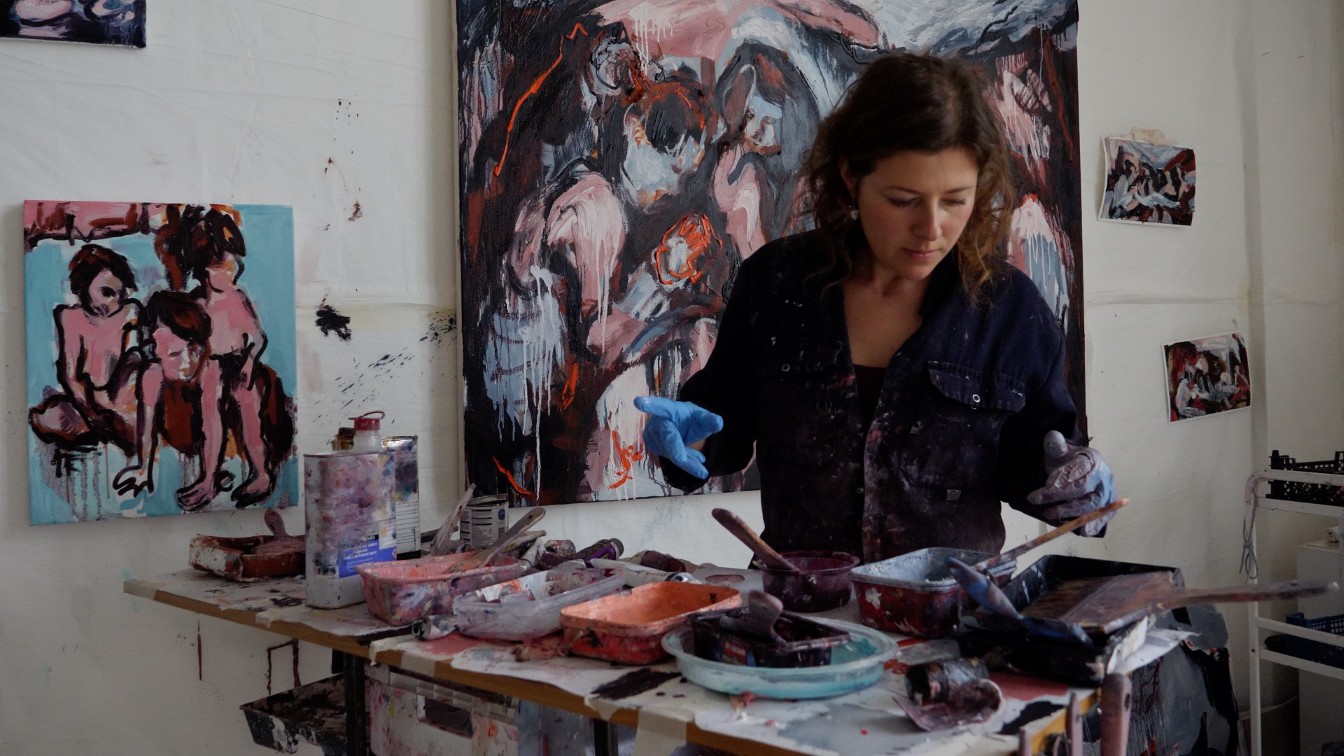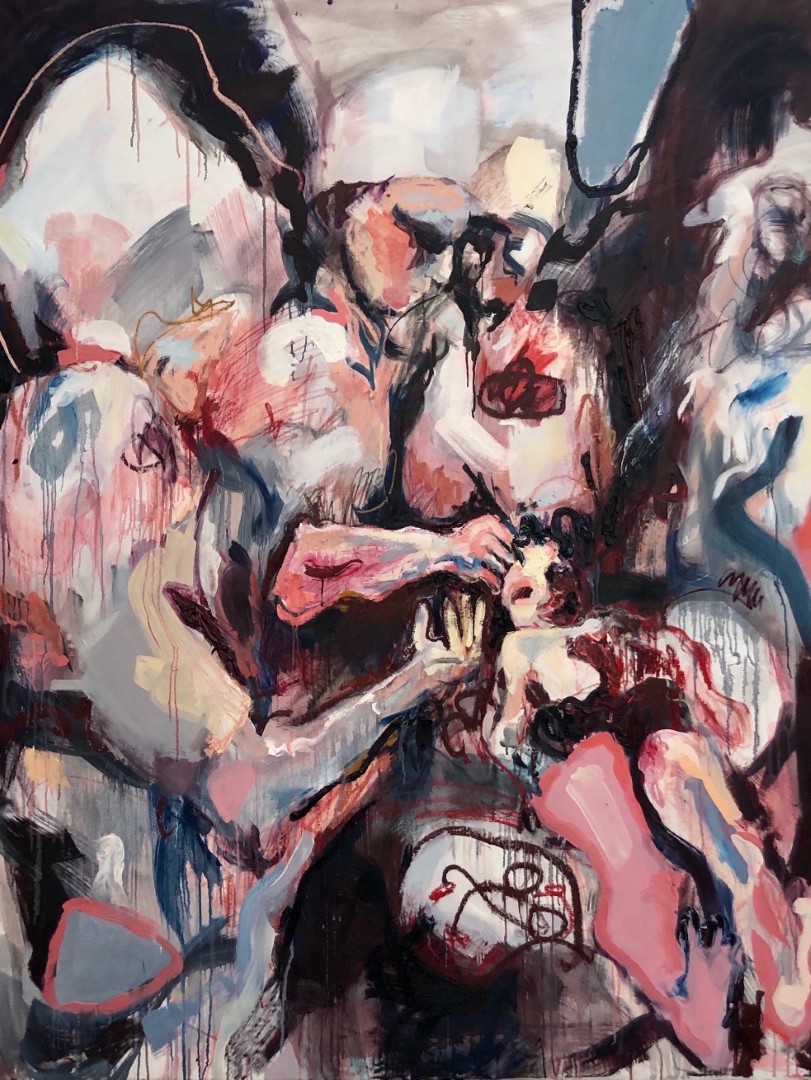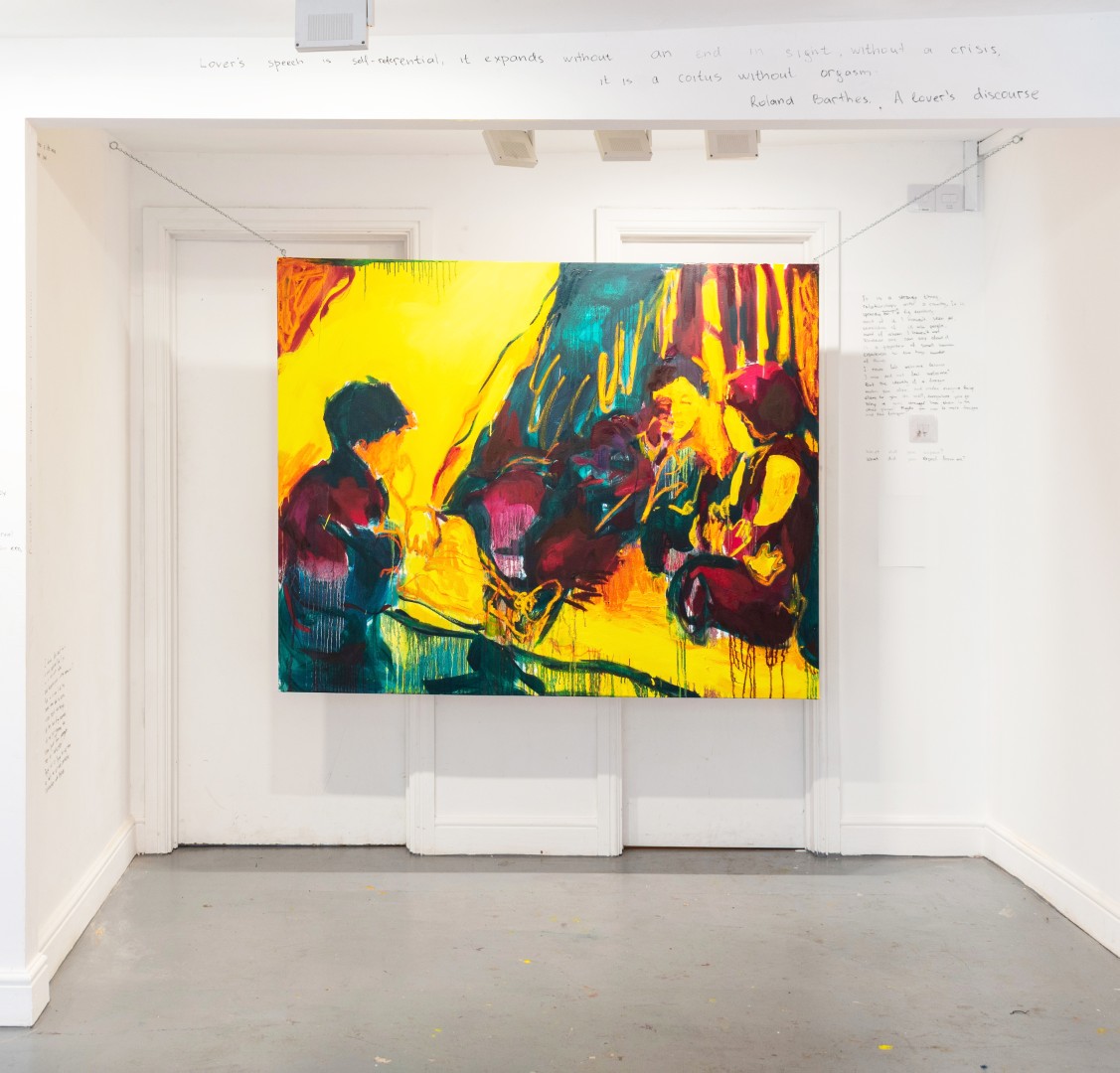Katya Granova Turns Found Photographs into Living Paintings
Katya Granova

Born in St. Petersburg in 1988, just before the fall of the USSR, Katya Granova grew up watching history rewrite itself in real time.
Now based in London, the painter transforms found and family photographs into gestural works that “rebel against the irreversibility of time.” Her paintings collapse memory and movement, with each brushstroke an attempt to enter, rather than simply observe, the past.
Granova’s work is featured in Small is Beautiful (43rd Edition) at Flowers Gallery, London (Nov 21 2025 – Jan 3 2026). A graduate of the Royal College of Art (RCA), Katya Granova has exhibited internationally, including with Shtager Gallery and Barbican Art Group Trust, and her work is held in the Royal College of Art’s permanent collection.
FAULT: You were born just before the fall of the USSR. How does that history shape your art today?
Katya Granova: Had I stayed in Russia, I would never have been able to see how exactly that history influences me. But being fortunate enough to live in different places and explore different worldviews, I could see my upbringing from the outside, and this is how I recognised what a crazy cultural setting formed me and how unusual my generation was. As kids, we witnessed extremely rapid political and cultural changes, and each of them was reflected in the similarly rapid updates of the national past. The USSR’s clear and consistent narratives about its past fell to pieces and were buried under the gravestone of newly declassified data about repressions and WWII, but were still strong enough to crawl out like zombies and influence chaotic public discourse. Conspiracy theories of all kinds were flourishing to fill the hunger for at least some comprehensible storyline. History books in school were changing before our eyes, and in this no-gravity historical space, the national past became a matter of personal preference. No one would be particularly surprised to have four different versions of the same events coexisting in one family, which was the case in my family, too. From inside, all that felt quite ordinary.
This groundlessness in many ways defined my interests and personality. I have this strong urge for objectivity about the past: something to lean on, something to help me define where to go and what to believe. But it also made me value freedom of thought so much. If the past can’t be objective, then I try to claim agency there in order to not have some propaganda reinforced over me. I’m a painter, but painting for me is, first of all, a tool to speculatively approach, touch, and bring my presence to a moment of the past, caged in the photograph.

What first drew you to working with found photographs?
Right before I went to the RCA in 2017, my granddad passed away, and I stayed with my grandma for a couple of weeks to support her. While sorting out his office, we kept coming across piles of old photographs – here and there, in dusty plastic bags from bread or chocolates, in total chaos – a family story spread across the entire 20th century. No one had ever shown me these before. So I volunteered to organise them: I bought some big vintage-style albums and started gluing pictures in. These images were pretty mundane – family and friends’ dinners, summer sea vacations, mothers with babies, work scenes –but together they felt like a very eventful and cheerful life, even if set in fairly dark times. I felt an urge to meet my young grandparents; they seemed so fun and free-spirited, but there was also a feeling that this is a real moment of the real past, something objective and really happening, but granddad is not here to tell anything about that. I didn’t have any idea of using them in art yet; I just developed a personal connection to them.
Immediately after that, I went to the RCA. It was by far not my first foreign experience, but somehow it was the most alienating. I didn’t feel like I fit in, and I kept overthinking why that might be and what I was doing wrong. That mixed with another experience: constantly replying to questions about where I was from. I felt that this identity was really defining me to people, that they did not see me through those – mostly negative – stereotypes. I used to think of myself as a world citizen, but there I felt very Russian, and I developed insecurity about my nationality, my accent, my way of socialising. That’s how I started wondering where I am actually from, what my culture is, my family, my history. Images from the family photographs were haunting me, because they carried all that, so I started reprinting them and painting over them. And very unexpectedly, I discovered a new expressivity and ease, unprecedented in my previous painterly practice: mixed triggers. Anger stemming from alienation, a desire to connect with my deceased family members and draw support from them, and an urge to claim agency in the objective past, a protest against time and death – all of this moved my body to react to the photographs, producing an intense, intrusive movement. Since then, I have always worked with photographs, simply because they create for me the ideal conditions for a strong and complex painterly response.
How do you choose which images to paint from?
It depends, but there are some constants. First of all, the photographs should be black and white. My choice of colour is a way of responding intuitively to the contents of the image. Then, they should be from before my birth to evoke the existential experience of engaging with a world without me. I prefer images with groups of people, because otherwise it becomes a portrait and all attention focuses on a single face and its expression. I’m not interested in conveying anything about the person depicted; what matters is that this whole scene is a moment from the unapproachable past. A face, a shoe, a tree, or a chair – all have the same ontological status of not existing anymore.
I like it when people are unaware of being photographed, as it feels more authentic, though such images are hard to find. Posed photographs can also be interesting, because everyone is subtly vying for attention, creating a composition where the eye cannot settle. This is similar to the whole experience of the past: it exists, but can we ever be certain of anything, when so many forces shape the past to their own benefits, when we are vulnerable to propaganda, when even our personal memories deceive us with false or confused details, when we constantly forget everything? Photographs can come from my family archive, from flea markets, from state archives, or from elsewhere, but I approach them differently. With images of unknown people, I fictionalise and imagine more and allow myself more playful interventions; with family photographs, I am more careful and tender.

What happens in your studio between a photo and a finished painting?
After choosing a photograph, I take a picture of it and print five or six copies on office paper. Then I paint over them, trying to see what my first colour response to its contents is. Mostly, I know immediately. For example, “this will be purple, yellow, pink, dark blue and sepia, done.” But it’s useful to check if the actual shades feel right. I then transfer the photograph onto a usually large canvas using methods like light-sensitive emulsions (cyanotype or Van Dyke), drawing from a projector, digital print, or simply using the image as compositional inspiration. Then I do my first layer. I like to listen to energising music during this process – often metal, hard rock, or intense classics like Beethoven – as I see my work, to some extent, as a dance: free movement guided by a physical desire to “climb” onto the photograph.
This part is the most fun for me, as decisions come easily, in a flow. In life, I can spend an hour deciding whether I want tea or coffee, so I really enjoy it when it’s like, “Want a red stripe here? Done!” Once the painting is underway, I work to add new, painterly voices that harmonise with what has already appeared, without removing or silencing anything – what has happened must stay. Deciding when to stop is the hardest part. In most cases, I think, “Okay, just a little more.” Then I feel I’ve overdone it, regret it, and suffer for a bit. Eventually, I think, “Whatever, I don’t care anymore,” do something unexpected, and then have a strong feeling of, “Yes, it’s done, I like it!” Sometimes I manage to avoid this stage of doubt, but my favourite works are not those executed very quickly, but those completed after much hesitation and reflection.
How does gesture guide your process?
Gestures are very important to me. I give my body the freedom to be triggered by the photograph, and my preferred large scale allows me to move not just with the hand, but from the shoulder, entering the canvas as a portal. Painting gives gesture materiality, cementing something ephemeral as movement. Looking at Rubens or Rembrandt 500 years later, we can still perceive the artist’s presence through brushwork, which carries their very present gestures. Through it, a painter inevitably communicates their presence, feelings, and personality like a dancer, but in a form that can endure for millennia. I find this truly fascinating about painting: it is how it challenges time and death, the most basic restrictions of our existence.
You often describe painting as “rebelling against the irreversibility of time.” What does that mean to you?
I was never happy with linear time. Since I understood it at the age of maybe five, I thought, “So this pleasant moment is now in the past and there’s no way I can be there again? That’s not cool!” We are nailed to the present, unable to pause or go back, and no one asked if we wanted to be born or to die –where did I sign up for that? Probably shaped by the particular historical time of my upbringing, I always felt constrained by the basic facts of human existence. As a child, I was fascinated by Soviet sci-fi literature for young people, which often mentioned time travel. I desperately wanted to construct a time machine. Existential questions led me to study psychology as my first degree, focusing on how the fundamental realities of life shape social behaviour.
Painting, as a way to preserve the artist’s gestural presence, is already a rebellion against time and death. But by speculatively inserting my presence into the photograph, I bring my living body to a dead moment, or the dead moment back to life. There are not that many ways to stand against the present becoming past every second, but what is worse is that there are not many ways to confront the fact that memory is shaped by privilege and power. For instance, so much is written about generals of WWII, but how much are the acts of women, children, or people of neglected ethnic, racial, and class identities honoured? My heroic great-grandmother, who completely alone protected her daughters and some other children through hunger, displacement, occupation, and war – completely inhuman conditions – did not get her place in school textbooks. History is never fair. So for me, my little world of painting over forgotten photographs is the only place where I can express some non-conformity towards both the human condition and ignorant, biased memory.
What’s the hardest part of painting the past?
I think I’m not really painting the past; I try to paint from my actual presence and the immediate, in-the-moment drive to intrude into the past. But there is often an ethical issue: dealing with someone else’s documented past is not consensual. I can’t ask people I paint from, say, 1910, if they are happy about it. I’ve brought them back, but how do I know if they want to be brought back? I sometimes feel morally unfair. I can, however, ask my parents when I paint from their past. They never minded the initial idea, but once, for example, my father said, “I was such a lovely baby in this photograph – and what the shit is that, I ask you?!”


Is there a particular memory or image you still feel compelled to paint?
I build a strong relationship with some photographs and like to paint them over and over again. For example, I have at least five works called Pediatric Surgery. They are all based on a beautiful photograph of my grandfather operating on a child in the 70s or even 60s. I love it because it captures the very essence of my grandfather, a brilliant surgeon and scientist, fully concentrated, as are his colleagues. No one noticed the camera, and all the eyes and compositional lines are directed toward the cut, the wound, as if it were Christ in a Renaissance or Baroque painting. I come from a medical family, so the scene of surgery is not disturbing to me; it is associated with giving life. Funnily enough, some collectors were distracted by the subject – “Oh, surgery, ewww” – but others loved it.
Another photograph I have used many times shows my grandmother reading a speech. My grandmother, also a doctor, was a very artistic person, so it might be her poem or some elevated words of congratulations. Again, no one looks at the photographer, as everyone is consumed by the dramatic scene my grandmother creates.
Both of these grandparents have sadly passed away, and I feel that, apart from intruding into the past and exploring the human condition, I paint to reconnect with them. This can also happen with strangers’ photographs. For example, I painted at least three versions of Seeing Their Grandma, a found photograph of two children and an older woman talking on a sunny day. I somehow established a connection to these people, not by meeting them, but through repeatedly painting them. They are like my family now.
What can viewers expect from your upcoming display at the Small is Beautiful exhibition at London’s Flowers Gallery?
This show features extremely small works, which was a huge challenge for me. I normally work on 2-metre tableaux, but here I was using tiny canvases of 13×18 cm. It was a very interesting challenge to bring the same energy and movement to the smallest scale I’ve ever used. I felt like a jeweler compared to my usual painting practice.
It was also very fruitful, and I think I will make more small works from now on. I used photographs of my grandparents that I had used before, but the results were surprising in terms of colour. On large-scale works, I usually mix paint in bulk to achieve repeated colours across the canvas, whereas here I mixed on the palette, used fewer brushes (most of mine are very large), and ended up with stranger, more complex colours. Small scale also allows for very thick impasto, which is technically almost impossible on larger works unless you have Anselm Kiefer’s workshop and an endless budget. Viewers can expect something new!

Katya Granova, what is your FAULT?
It is my fault that I often stayed where I was uncomfortable or moved somewhere because of some guy. It is, in a way, surprising. I was raised by driven and ambitious women; no one in my family was a housewife. Even more, my second grandmother was literally a criminal investigator catching serial killers, while my mum was in a nursery. Still, having no partner is widely considered a kind of failure in pop culture, and not just in Russia. I was turning my life upside down for truly intense love, and this still feels a fair reason, but, however, several times I lied to myself and acted out of fear of being forever single. I had to get quite late in life to realise how much I had been brainwashed in this regard. This is the only thing in life I truly regret.
Sometimes I also think, “Oh, if I had just stayed in one place, I probably would have built a far more stable and supportive social circle and a better career,” but that just wouldn’t be me. According to one Russian expression, I am “the one with the awl in the ass,” meaning I can never sit in one place for long. I value my freedom of movement and thought above all, and that influences my art, my ideas, and simply who I am. One should never regret being authentic to one’s self, even if it interferes with their goals, but I do regret acting under the influence of traditionalist brainwashing instead.